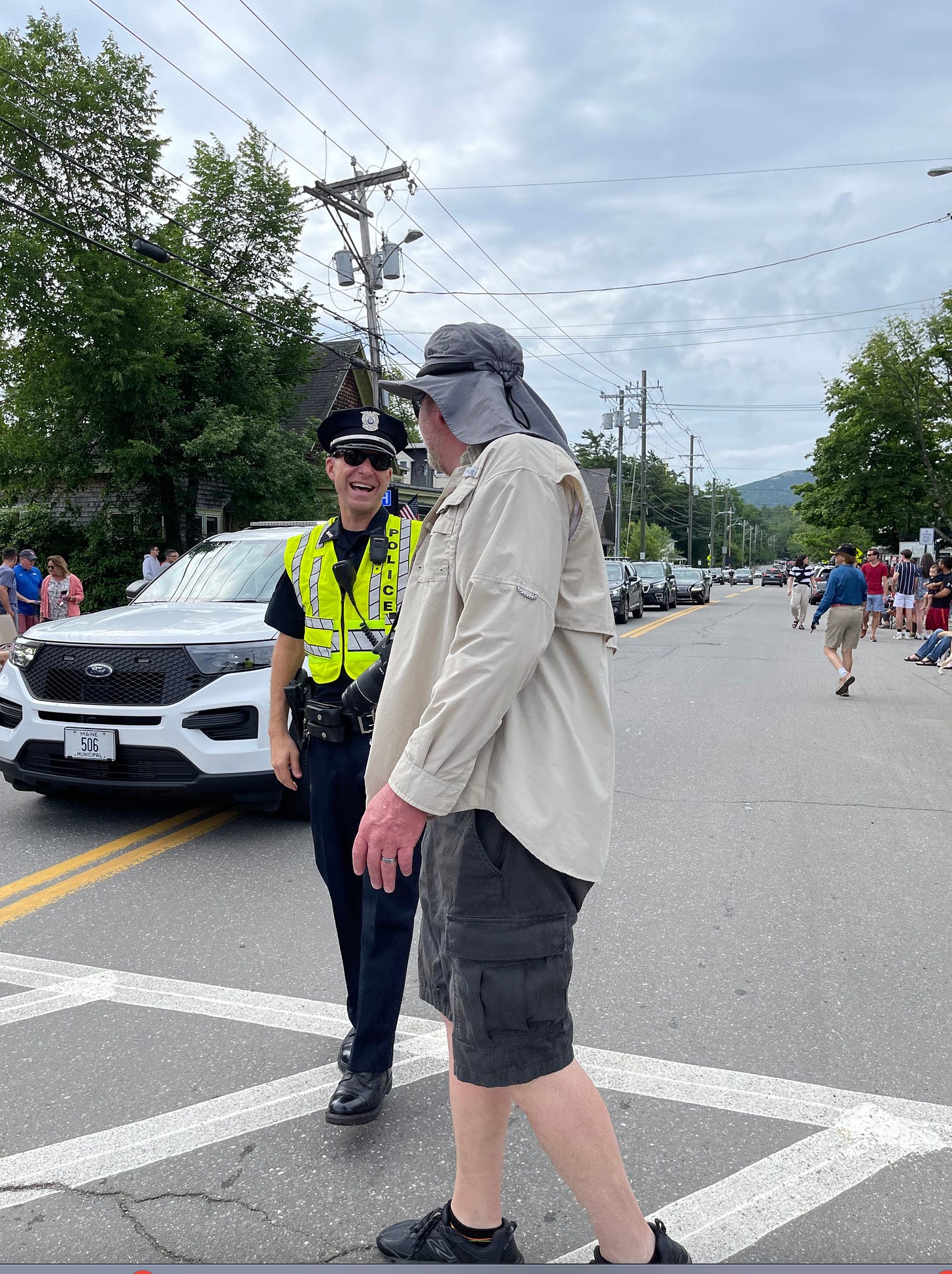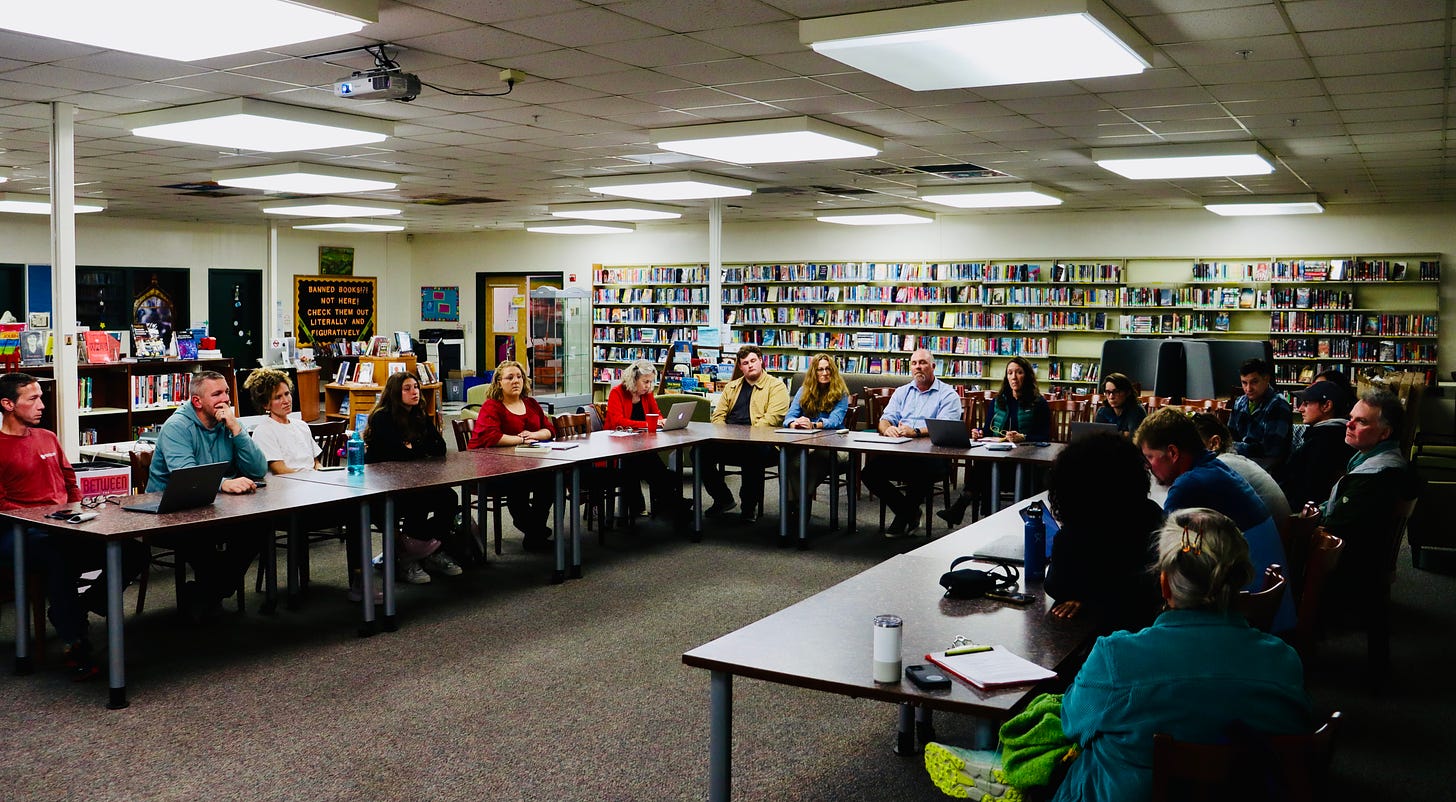High School Board Worries That Tim Bland May No Longer be School Resource Officer
Computerized Testing Glitch Causes Frustration
BAR HARBOR––Before heading into discussion about testing glitches and renewing an agreement to have a school resource officer in the high school, MDI High School Principal Matt Haney told attendees at the October 16 MDI High School Board that it’s just been a great start to the school year. There have been great leaders (upper grade students) this year.
“It just feels great to be around the building this year and that is what it’s all about. The students are just crushing it,” he said.
SCHOOL RESOURCE OFFICER MEMORANDUM OF UNDERSTANDING
The board split when it came to renewing the school resource officer (SRO) memorandum of understanding (MOU) with the Bar Harbor/Mount Desert Police Department.
Because of Police Chief Jim Willis’ retirement earlier this year, the police department has undergone some temporary restructuring and Officer Tim Bland has taken on more of a leadership role within the police department, Haney said. Bland is not currently available to perform the duties of the SRO. This triggered conversation amongst the board members.
Many board members expressed that they would not want to have an SRO in the schools if it was not Bland and said that the existing MOU only existed because it was Bland who was chosen to be the SRO. Members also brought up the need to re-engage the community if another officer had to be chosen to be the SRO and resisted letting the police department simply choose that person.
Yarborough said, “I don’t see, if there is a change, even though you would recommend it, and do all of your due diligence, I don’t see this just not being, not having, people not caring in the community.” She asked if he had thought about public participation if there is a new person in the position?
“I have not thought about it any deeper than the points that you just brought up. I am fully aware of how foolish it would be to just plop someone in here without community feedback,” said Haney. “I am not going to just plug in a new person if Tim (Bland) moves out of that role.”
Bar Harbor School Committee Chair Lilea Simis said that they have to be careful indicating that the MOU and Bland are the same. They still need to have the MOU and just because they all felt good about Bland because it was Bland, they can’t lay the groundwork for Bland as the kingpin. The MOU still needs to exist, regardless.
Haney said that the MOU gives the board wide latitude to make decisions and they can terminate the agreement if they feel the need and have other options written into the MOU that don’t lock them in to anything.
Southwest Harbor School Board Chair John Bench made the motion to approve the memorandum and Bar Harbor’s Tyson Starling seconded the motion. The vote was spilt with members Beau Lisy (Southwest Harbor) and Eliza Bishop (Tremont) voting in opposition.
TESTING RESULTS AND TEST TRIALS AND TRIBULATIONS
The meeting soon delved into other parts of the principal’s update, one of which was some recent assessment results that were measured by standardized tests that were taken by the incoming freshmen and last year’s freshmen in the fall of 2022 and test results for the same two groups of students from tests taken in the spring of this year.
Dean of Curriculum Jill Cohen presented the results and some relevant explanation of the results, explained which tests were taken, and by whom. There were three different standardized tests (two of which are state mandated) given, but at the time of the meeting they only had results for two of the tests.
She presented results from the NWEAs and the Maine Through Year Assessment. The Maine Through Year Assessment is a new test. This was the first time that sophomores have taken it in their school careers. Cohen said this test is not the same as the NWEA test is structured differently. More than one answer can be correct on many of its questions.
All participating students took the tests simultaneously, October 11. This equated to 200 students and approximately 25 teachers online at the same time which caused the entire system to lock up. This system crash had also occurred during an earlier orientation test day. The orientation day was just for familiarity. Unfortunately, every time the system was rebooted on test day, it placed the students back at the first question on the test.
The results of two test subjects were presented, math and reading, both for current freshmen and sophomores. Testing is not mandatory and parents may allow their students to opt out of the testing.
Freshmen math (NWEA) -
92% participated;
55% placed at “college and career readiness.;
34% met their growth target.
Freshman reading (NWEA) -
91% participated;
63% placed at “college and career readiness;”
38% met their growth target.
Progress for the NWEA is measured from fall of one year to spring of the next. “College and career readiness” means that students tested in the 60th percentile or above. The 50th percentile is “at grade level.”
Sophomore math (Maine Through Year Assessment) –
81% participated;
54% met or exceeded their growth target;
26% met their target growth.
Sophomore reading (Maine Through Year Assessment) –
81% participated;
78% met or exceeded their growth target;
18% met their growth target.
About 91% of sophomores who took NWEA last year as freshman in the spring took the Maine Through Year Assessment this fall.
The state has its own guidelines for the Through Year Assessment which are different from the NWEA. There are four levels of measurement:
Well below,
Below,
Meeting or at,
Above.
Cohen said that the growth target numbers were lower than expected and lower than what they normally see. She said there are four factors that influenced lower growth rates.
Tech problems on test day. Students were rushing to finish in case of another system crash;
Test apathy. By ninth and tenth grade, students have figured out that these assessments don’t mean anything for their future or college admissions;
Grade levels that were most impacted by COVID;
MDI data is consistent with data across the state;
She also said that the school will use this year’s testing as year one in data to focus on areas of improvement for students.
One board member asked if there is a mechanism in place where school administration could check in with teachers to see how students are actually doing in the classroom since the test data appears to be skewed.
Cohen responded that testing is just one piece of a very big puzzle. They look at many indicators, including test results, that might indicate where teachers need to focus their instruction on particular areas for particular students. Cohen also said that the students are tested by advisory group and not by classroom, so the results don’t necessarily reflect a teacher’s ability.
Bar Harbor School Committee Vice Chair Marie Yaborough thanked the school for acknowledging that there is a COVID-19 gap and for not trying to sugarcoat the technological issues with the testing. She asked, “Was it our network that couldn’t handle it or was it where the test lived that couldn’t handle it? What couldn’t handle the two hundred?”
Haney said that it was a school problem because he reached out to neighboring schools and nobody else was having those issues during the testing.
LUNCH PROGRAM
Haney then spoke about the school’s lunch program and said that even with more variety and more offerings, the number of students who eat a school lunch remains about the same. Approximately 44% of students get school lunch this year. Approximately 45% participated last year.
Haney jokingly said that he believes that the elimination of “nugget day” (chicken nuggets) plays a big part in the lack of increased participation that they were hoping for. Nugget days were very popular.
Other than nutritional values and healthy options, school lunches don’t normally have a big role in how people think about schools or school budgets, but Haney presented some numbers about the rates of reimbursement that the school receives for school lunches, which are free to all students.
The high school is currently receiving just above $2000 a month in reimbursement for school lunches.
48 cents for students who would pay full price if they had to pay.
$4.00 for students who would qualify for a reduced price if they had to pay.
$4.50 for students who would qualify for free lunch if they had to pay.
Haney said that there is super low participation in the reduced and free lunch programs because students eat for free. However, that is money that the school could be receiving that would offset some of the balance of the general school budget and reduce the taxpayer burden.
A board member said about the application process, “I don’t love putting financial information on a piece of paper like that that gets circulated in the front office.”
Haney responded to this by saying that it is actually a digital application which is not hard or very time consuming to fill out. The application is on Schoology, but unfortunately, it is buried in the middle of a bunch of other forms and the sum total of all of these forms does take some time to get through.
The information that goes on the form is very closely guarded, Haney said, and only the one person who transfers the data from the form is supposed to have access to it. Haney said that he himself doesn’t even have access to it, and it qualifies as some of the most protected information that they have.
Yarborough suggested making the form more easily accessible and informing parents of how this can impact the overall school budget by reducing tax dollars needed for the budget.
EXECUTIVE SESSION AND BUDGET
Before moving into executive session to evaluate Superintendent Mike Zboray, Haney said that the school’s budget will start being talked about at the board’s next meeting. He said that he will have a rough overview to look at in November and should have a first draft of the budget ready for the December meeting.
The board’s next meeting will be November 13. The time of the meeting has yet to be determined but will most likely be 5 p.m.
MDI REGIONAL HIGH SCHOOL BOARD OF TRUSTEES MEETING
During the September 25 Board of Trustees meeting, members had the opportunity to discuss the final report submitted by Haley-Ward, which is the company that was hired to help with the wastewater issues at the high school. A large part of this project is not only the three wastewater disposal system options but the possible elimination of PFAS from the wastewater disposal system leaking into the surrounding ground and water tables.
The three options given by Haley-Ward are, rebuild the existing lagoon system, install a new more traditional system with septic tank and leach field, or connect to the wastewater treatment plant in Somesville.
The costs of each of the three options, as estimated by Haley-Ward are:
Rehabilitate existing treatment system – $267,000.00
Subsurface wastewater disposal system – $2,506,000.00
Convey wastewater to Somesville publicly operated treatment works – $5,076,000.00
High School Principal Matt Haney said that he thought that they had enough money in the high school budget to pay for the rehabilitation of the existing lagoon system which would allow them to renew their permit with the Maine DEP for another five years. He said that he would try and verify this by the next Trustees’ meeting.
Board of Trustees member Carole Plenty asked if the only way to truly eliminate PFAS leaching into the ground and water tables was to connect to the Somesville wastewater treatment plant.
Many members voiced the opinion that they should probably rehabilitate the existing lagoon system, renew the permit with the DEP, and then move on to figuring out funding for the connection to the wastewater treatment plant. It was also stated during the meeting that it may cost less than the full estimate to get the existing lagoon system rehabilitated enough to simply renew the permit.
There was a Haley-Ward representative at the meeting, and she was asked if the big price tag for the treatment plant connection included the money necessary for the initial step of rehabilitating the existing lagoon system. The representative was unable to answer this question, along with a few others that were asked, but it was determined that she would try to get those answers prior to the next meeting.
Member Tony Smith made a motion that Haley-Ward, as part of its services offered, research possible funding options (grants) for the connection to the wastewater treatment plant project at the state and federal levels and bring the results back to the next meeting. Member Robert Webber seconded the motion and the vote was unanimous.
The next trustees board meeting will be Monday, October 23 at the MDI High School Library at 5:30.








Thank you for your thorough coverage of school board meetings. I have no direct stake in the school system except indirectly through payment of our share of Birch Bay's taxes, however, everyone has a stake in the outcome as it relates to the future of our society.